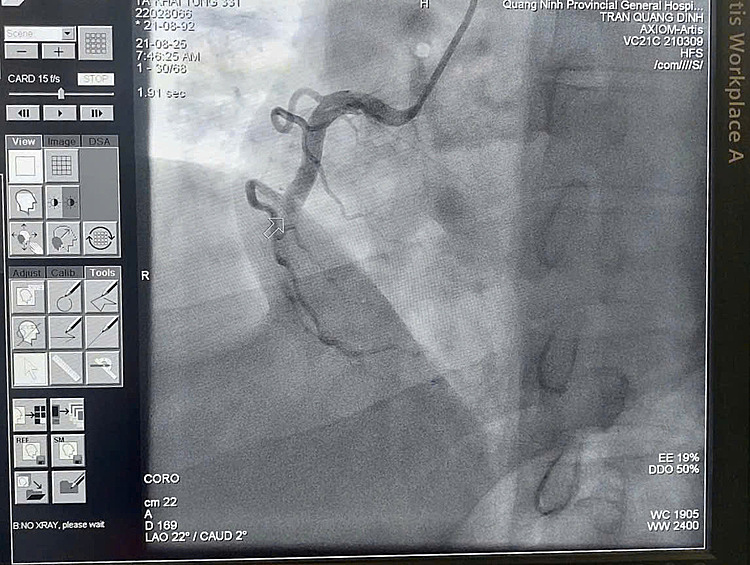On 22/8, representatives from Cam Pha Regional General Hospital reported that a patient was admitted with worsening shortness of breath. An electrocardiogram (ECG) revealed a classic inferior myocardial infarction (heart attack). The patient received initial emergency treatment with antiplatelet medications, including aspirin and clopidogrel, before being transferred to the provincial general hospital for specialized treatment and intervention.
A coronary angiogram revealed severe damage and complete blockage of a section of the right coronary artery. The intervention team successfully placed a stent, restoring blood flow.
The patient is now conscious, hemodynamically stable, and experiencing less chest pain. As he had no prior underlying health conditions, doctors are conducting further tests to determine the cause.
 |
Angiogram showing the blocked coronary artery. Photo: Hospital provided |
Angiogram showing the blocked coronary artery. Photo: Hospital provided
According to the American Heart Association, the incidence of heart attacks in young people under 45 is increasing, currently accounting for 6-10% of all heart attack cases. This is a significant cause of illness and death in young people worldwide.
Besides congenital factors and underlying diseases, lifestyle choices are the primary cause of heart attacks in young people. These include being overweight, lack of exercise, stress, and excessive tobacco and alcohol use. This group often assumes their youth protects them from diseases typically associated with older age, only realizing they've had a heart attack when they experience severe chest pain and are hospitalized. In many cases, patients arrive at the hospital with myocardial necrosis (tissue death), heart failure, or sudden cardiac arrest.
Like the patient mentioned above, heavy and prolonged smoking is a significant risk factor for heart attacks. Long-term smoking causes chronic atherosclerosis in all blood vessels throughout the body. These atherosclerotic plaques gradually narrow the arteries, leading to heart attacks and strokes.
Other factors, such as high blood pressure, high blood sugar, and family history, also increase the risk. If not properly managed, dyslipidemia (abnormal blood lipids) can cause atherosclerosis, leading to heart attacks, strokes, and peripheral artery disease. Hospitals have reported a rapid increase in hypertension and diabetes cases over the past 10 years, significantly contributing to the increasing prevalence of heart disease in younger individuals.
Symptoms of a heart attack include severe chest pain or discomfort lasting more than 20 minutes, which may radiate to the left arm, jaw, or back; shortness of breath; sweating; nausea or vomiting; dizziness or fainting; and heart palpitations. In younger individuals, symptoms may be atypical and easily mistaken for stomach pain, acid reflux, or anxiety.
Doctors recommend managing risk factors and maintaining a healthy weight. This includes limiting alcohol consumption, quitting smoking, eating plenty of fruits, vegetables, and whole grains, avoiding fast food, processed fats, and fried foods, and engaging in daily physical activity. From age 40 onwards, individuals should undergo regular checkups including heart ultrasounds, ECGs, and blood tests for lipids, blood sugar, and blood pressure.
Thuy Quynh












